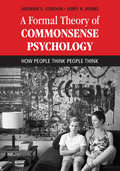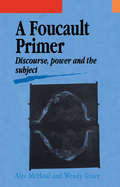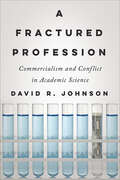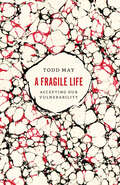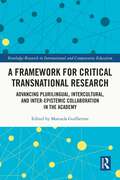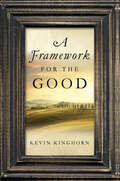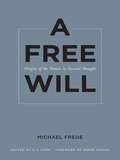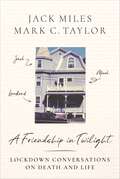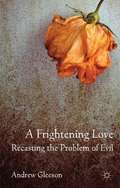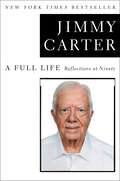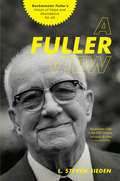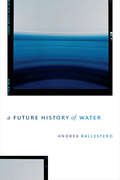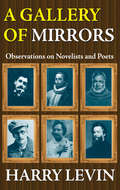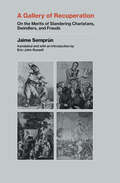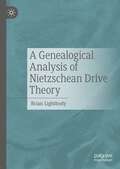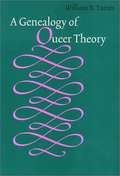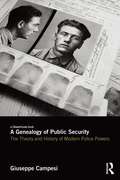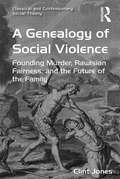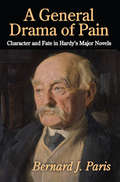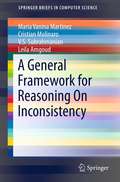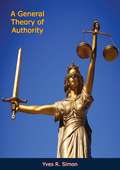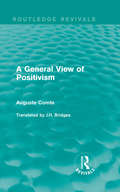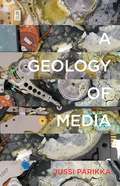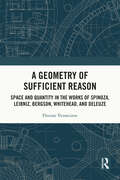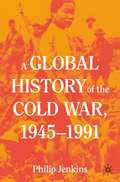- Table View
- List View
A Formal Theory of Commonsense Psychology: How People Think People Think
by Andrew S. Gordon Jerry R. HobbsCommonsense psychology refers to the implicit theories that we all use to make sense of people's behavior in terms of their beliefs, goals, plans, and emotions. These are also the theories we employ when we anthropomorphize complex machines and computers as if they had humanlike mental lives. In order to successfully cooperate and communicate with people, these theories will need to be represented explicitly in future artificial intelligence systems. This book provides a large-scale logical formalization of commonsense psychology in support of humanlike artificial intelligence. It uses formal logic to encode the deep lexical semantics of the full breadth of psychological words and phrases, providing fourteen hundred axioms of first-order logic organized into twenty-nine commonsense psychology theories and sixteen background theories. This in-depth exploration of human commonsense reasoning for artificial intelligence researchers, linguists, and cognitive and social psychologists will serve as a foundation for the development of humanlike artificial intelligence.
A Foucault Primer: Discourse, Power And The Subject (Interpretations Ser.)
by Alec McHoul Wendy GraceWho are we today? That deceptively simple question continued to be asked by the French historian and philosopher, Michel Foucault, who for the last three decades has had a profound influence on English-speaking scholars in the humanities and social sciences.; This text is designed for undergraduates and others who feel in need of some assistance when coming to grips with Foucault's voluminous and complex writings. Instead of dealing with them chronologically, however, this book concentrates on some of their central concepts, primarily Foucault's rethinking of the categories of "discourse", "power", and " the subject".; Foucault's writings contribute collectively to what he himself calls "an ontology of the present". His historical research was always geared towards showing how things could have been and still could be otherwise. This is especially the case with respect to the production of human subjects.
A Fractured Profession: Commercialism and Conflict in Academic Science (Critical University Studies)
by David R. JohnsonExploring the growing division among academic scientists over a profit motive in research.The commercialization of research is one of the most significant contemporary features of US higher education, yet we know surprisingly little about how scientists perceive and experience commercial rewards. A Fractured Profession is the first book to systematically examine the implications of commercialization for both universities and faculty members from the perspective of academic scientists. Drawing on richly detailed interviews with sixty-one scientists at four universities across the United States, sociologist David R. Johnson explores how an ideology of commercialism produces intraprofessional conflict in academia.The words of scientists themselves reveal competing constructions of status, conflicting norms, and divergent career paths and professional identities. Commercialist scientists embrace a professional ideology that emphasizes the creation of technologies that control societal uncertainties and advancing knowledge toward particular—and financial—ends. Traditionalist scientists, on the other hand, often find themselves embattled and threatened by university and federal emphasis on commercialization. They are less concerned about issues such as conflicts of interest and corruption than they are about unequal rewards, unequal conditions of work, and conflicts of commitment to university roles and basic science.Arguing that the division between commercialists and traditionalists represents a new form of inequality in the academic profession, this book offers an incisive look into the changing conditions of work in an era of academic capitalism. Focusing on how the profit motive is reshaping higher education and redefining what faculty are supposed to do, this book will appeal to scientists and academics, higher education scholars, university administrators and policy makers, and students considering a career in science.
A Fragile Life: Accepting Our Vulnerability
by Todd MayIt is perhaps our noblest cause, and certainly one of our oldest: to end suffering. Think of the Buddha, Chuang Tzu, or Marcus Aurelius: stoically composed figures impervious to the torments of the wider world, living their lives in complete serenity—and teaching us how to do the same. After all, isn’t a life free from suffering the ideal? Isn’t it what so many of us seek? Absolutely not, argues Todd May in this provocative but compassionate book. In a moving examination of life and the trials that beset it, he shows that our fragility, our ability to suffer, is actually one of the most important aspects of our humanity. May starts with a simple but hard truth: suffering is inevitable. At the most basic level, we suffer physically—a sprained ankle or a bad back. But we also suffer insults and indifference. We suffer from overburdened schedules and unforeseen circumstances, from moral dilemmas and emotional heartaches. Even just thinking about our own mortality—the fact that we only live one life—can lead us to tremendous suffering. No wonder philosophies such as Buddhism, Taosim, Stoicism, and even Epicureanism—all of which counsel us to rise above these plights—have had appeal over the centuries. May highlights the tremendous value of these philosophies and the ways they can guide us toward better lives, but he also exposes a major drawback to their tenets: such invulnerability is too emotionally disengaged from the world, leading us to place too great a distance between ourselves and our experience. Rather than seeking absolute immunity, he argues most of us just want to hurt less and learn how to embrace and accept what suffering we do endure in a meaningful way. Offering a guide on how to positively engage suffering, May ultimately lays out a new way of thinking about how we exist in the world, one that reassures us that our suffering, rather than a failure of physical or psychological resilience, is a powerful and essential part of life itself.
A Framework for Critical Transnational Research: Advancing Plurilingual, Intercultural, and Inter-epistemic Collaboration in the Academy (Routledge Research in International and Comparative Education)
by Manuela GuilhermeBy foregrounding successful transnational research projects conducted across Latin America and Europe, this edited collection contests epistemological hegemony and heterogeneity in the academy and highlights feasible models for research cooperation across diverse languages, cultures, and epistemologies. Chapters focus on the practical and theoretical tenets of responsible intra-national research and propose the "Glocacademia" framework as a means of enhancing critical reflection on issues that can inhibit plurilingual, intercultural, and inter-epistemic research. The text offers key recommendations to support institutions and researchers to develop intercultural awareness, multi-level citizenship, and a readiness to embrace diverse knowledge ecologies. The book builds on existing discussions on multiculturalism, interculturality, and transculturality to offer high academic value to the discussion of higher education and research. Offering important contributions to the study of global academic research, this volume will be of interest to scholars and researchers with an interest in international and comparative education, as well as multicultural studies in education research.
A Framework for the Good
by Kevin KinghornThis book provides an ethical framework for understanding the good and how we can experience it in increasing measure. In Part 1, Kevin Kinghorn offers a formal analysis of the meaning of the term "good," the nature of goodness, and why we are motivated to pursue it. Setting this analysis within a larger ethical framework, Kinghorn proposes a way of understanding where noninstrumental value lies, the source of normativity, and the relationship between the good and the right. Kinghorn defends a welfarist conception of the good along with the view that mental states alone directly affect a person's well-being. He endorses a Humean account of motivation—in which desires alone motivate us, not moral beliefs—to explain the source of the normative pressure we feel to do the good and the right. Turning to the place of objectivity within ethics, he concludes that the concept of "objective wrongness" is a misguided one, although a robust account of "objective goodness" is still possible. In Part 2, Kinghorn shifts to a substantive, Christian account of what the good life consists in as well as how we can achieve it. Hume's emphasis of desire over reason is not challenged but rather endorsed as a way of understanding both the human capacity for choice and the means by which God prompts us to pursue relationships of benevolence, in which our ultimate flourishing consists.
A Free Will
by David Sedley Michael Frede A. A. LongWhere does the notion of free will come from? How and when did it develop, and what did that development involve? In Michael Frede's radically new account of the history of this idea, the notion of a free will emerged from powerful assumptions about the relation between divine providence, correctness of individual choice, and self-enslavement due to incorrect choice. Anchoring his discussion in Stoicism, Frede begins with Aristotle--who, he argues, had no notion of a free will--and ends with Augustine. Frede shows that Augustine, far from originating the idea (as is often claimed), derived most of his thinking about it from the Stoicism developed by Epictetus.
A Friendship in Twilight: Lockdown Conversations on Death and Life
by Jack Miles Mark C. TaylorIn a time of plague, fundamental questions become immediate and personal. The pandemic, droughts, floods, fire, political violence: the world has been grimly reminded of the proximity and inevitability of death. Jack Miles and Mark C. Taylor—acclaimed public intellectuals and scholars of religion, one a Christian and the other an atheist, close friends for fifty years—have spent their lives grappling with questions of ultimate concern. At the onset of the COVID-19 pandemic, locked down at home and facing an uncertain future, Miles and Taylor embarked on an extended conversation about living and dying in an imperiled world.A Friendship in Twilight is their plague journal. In raw and searching letters, written daily from the first lockdowns through the Capitol riot, Miles and Taylor reflect on life during overlapping crises. Amid the menace of the pandemic and the unceasing political turmoil, they debate the lessons that a catastrophic present can teach about the future and how to read, think, live, and face up to death. Confronting the vulnerability of their aging bodies and the frailty of American democracy, the two friends discuss why and how philosophical reflection matters for a wounded world. Their conversations are imbued with an ever-present sense of urgency about the worth of a life, the fragility of existence, and the uncertainty of endings. Seamlessly moving from heartfelt emotion to philosophical speculation, current events to great art and literature, this book is a powerful and moving testament to the precarity of life and to enduring friendship.
A Frightening Love: Recasting the Problem of Evil
by Andrew GleesonA Frightening Love radically rethinks God and evil. It rejects theodicy and its impersonal conception of reason and morality. Faith survives evil through a miraculous love that resists philosophical rationalization. Authors criticised include Alvin Plantinga, Richard Swinburne, Marilyn McCord Adams, Peter van Inwagen, John Haldane, William Hasker.
A Full Life: Reflections at Ninety
by Jimmy Carter"A warm and detailed memoir." --Los Angeles Times Jimmy Carter, thirty-ninth President, Nobel Peace Prize winner, international humanitarian, fisherman, reflects on his full and happy life with pride, humor, and a few second thoughts.At ninety, Jimmy Carter reflects on his public and private life with a frankness that is disarming. He adds detail and emotion about his youth in rural Georgia that he described in his magnificent An Hour Before Daylight. He writes about racism and the isolation of the Carters. He describes the brutality of the hazing regimen at Annapolis, and how he nearly lost his life twice serving on submarines and his amazing interview with Admiral Rickover. He describes the profound influence his mother had on him, and how he admired his father even though he didn't emulate him. He admits that he decided to quit the Navy and later enter politics without consulting his wife, Rosalynn, and how appalled he is in retrospect. In A Full Life, Carter tells what he is proud of and what he might do differently. He discusses his regret at losing his re-election, but how he and Rosalynn pushed on and made a new life and second and third rewarding careers. He is frank about the presidents who have succeeded him, world leaders, and his passions for the causes he cares most about, particularly the condition of women and the deprived people of the developing world. This is a wise and moving look back from this remarkable man. Jimmy Carter has lived one of our great American lives--from rural obscurity to world fame, universal respect, and contentment. A Full Life is an extraordinary read.
A Fuller View
by L. Steven SiedenKnown as a "Leonardo da Vinci of the twentieth century," engineer, designer, inventor, and futurist Dr. R. Buckminster "Bucky" Fuller had a keen awareness that we're all in this together. Understanding that humans don't have aclue about how to operate our fragile Spaceship Earth, Buckminster provided insightful design science solutions to our most challenging issues, including war, overpopulation, housing, increasing inflation, health care, the energy crisis, and much more. For all its genius, Fuller's legacy has yet to be fully discovered. Noted Fuller expert L. Steven Sieden together with Gary Zukav, John Robbins, Lynne Twist, Jean Houston, and many other notable individuals offer inspiring quotations and explanations that make Fuller's life more understandable and accessible. They preserve a voice that calls upon each of us to shift our intellectual and technological resources from creating weaponry to creating sustainability.Winner 2013 COVR award - Gold
A Future History of Water
by Andrea BallesteroBased on fieldwork among state officials, NGOs, politicians, and activists in Costa Rica and Brazil, A Future History of Water traces the unspectacular work necessary to make water access a human right and a human right something different from a commodity. Andrea Ballestero shows how these ephemeral distinctions are made through four technolegal devices—formula, index, list and pact. She argues that what is at stake in these devices is not the making of a distinct future but what counts as the future in the first place. A Future History of Water is an ethnographically rich and conceptually charged journey into ant-filled water meters, fantastical water taxonomies, promises captured on slips of paper, and statistical maneuvers that dissolve the human of human rights. Ultimately, Ballestero demonstrates what happens when instead of trying to fix its meaning, we make water’s changing form the precondition of our analyses.
A Gallery of Mirrors: Observations on Novelists and Poets
by T. TregearThe essays in this classic volume range from broad concerns with critical theory and aesthetic formulation to specific analysis of forms and texts. Levin discusses such matters as the symbolic interpretation of literature, the development of literary criticism during the past half-century, European attitudes toward contemporary American writers, and re-evaluations of Joyce, Proust, Balzac, Cervantes, Melville, and Hemingway. Because Levin is both a learned scholar and imaginative critic, there is no comparable book that offers the wit, taste, and learning one finds in these pages. His historical and comparative approaches to literary theory enable Levin to place a given work precisely by relating it to other works and manifestations of culture. World literature is not the province of this work. But Levin views it as the horizon against which our own traditions may be measured. Just as anthropologists discover similar processes working through diverse cultures, so through can we glean understanding of common patterns through the analysis of world literature, our own peculiarly specialized branch of the science of man. The effect of convention, in shaping the extent to which literature may be conceived as an institution, has been widely discussed. A Gallery of Mirrors raises theoretical questions that touch the methodology of humanistic scholarship, with regard to other disciplines, and the status of art, with regard to other modes of knowledge. With changing schools of critical thought, Levin relies considerably on semantics as a precision instrument for defining concepts in the terms of those for whom they were most meaningful.
A Gallery of Recuperation: On the Merits of Slandering Charlatans, Swindlers, and Frauds
by Jaime SemprunThe first English translation of the French cult classic that lampoons France&’s most popular intellectuals of the post-1968 period and their ideas, which became forces of counterrevolution.Eric-John Russell&’s translation of Jaime Semprún&’s brutal takedown of France&’s best-known intellectuals of the post-1968 period, A Gallery of Recuperation, is one of the first full English versions of any of Semprún&’s books. Originally titled Précis de recuperation, the book is a scathing critique of ten major thinkers, including Michel Foucault, Gilles Deleuze, Jean-François Lyotard, and Cornelius Castoriadis. Semprún uses this catalog of careerism to reflect on the concept of recuperation—capitalism&’s uncanny ability to coopt anticapitalist critiques and subvert subversion. His central question: What happens to revolutionary ideas, including Marxism itself, in the hands of professional intellectuals?Semprún&’s idiosyncratic and playful style of polemics takes existentialism, humanism, structuralism, poststructuralism, postmodernism, aesthetics, and psychoanalysis to task, casting new light on the figures who have become dominant staples of modern Anglophone academia, and proving the necessity of critiquing intellectuals&’ roles within contemporary capitalism. A cult classic among the French radical left and scholars of the Situationist International and May 1968, A Gallery of Recuperation never made the impact it should have. Russell&’s translation marks a major step in recognizing Semprún&’s work beyond its French context.
A Genealogical Analysis of Nietzschean Drive Theory
by Brian LightbodyNietzsche’s “drive theory”, as it is referred to in the secondary literature, is a rich, unique and fascinating articulation of the human condition. In broad brushstrokes, Nietzsche appears to contend that all human psychology is either directly reducible to animal drives (e.g. sex, aggression) or indirectly explicable to the historical transformations thereof (e.g. ressentiment). Moreover, Nietzsche’s initial elucidation of drive theory in On the Genealogy of Morals (and elsewhere) is well-complemented with a fecund, profound, and clear elucidation of the concept in the secondary literature. Yet, there remains a glaring lacuna for all the discussion of drive theory in the scholarship. The secondary literature is delinquent in explaining how animal drives became incorporated to form the human psyche. Nietzsche’s account to elucidate how drives became “digested” or in his words “inpsychated” is called the Internalization Hypothesis. However, as it appears in GM: II, 16, the hypothesis is grossly inchoate. The result of this undertheorization is manifold; its deleterious effects resonate along many axes of Nietzsche’s philosophy. The present book, Internalized Valuation: A Genealogical Analysis of Nietzschean Drive Theory, offers an original and fruitful interpretation of Nietzsche’s philosophical psychology. First, it clarifies what drives are. Second, it provides a new way of thinking about Nietzsche’s genealogical methods and then applies these insights to The Genealogy itself. What follows is a work that not only sheds much-needed light on Nietzsche’s philosophy of mind in general and his theory of emotions in particular, but also informs and illuminates problematic passages of Nietzsche’s Genealogy.
A Genealogy Of Queer Theory (American Subjects)
by William B. Turner<p>Who are queers and what do they want? Could it be that we are all queers? Beginning with such questions, William B. Turner's lucid and engaging book traces the roots of queer theory to the growing awareness that few of us precisely fit standard categories for sexual and gender identity. <p>Turner shows how Michal Foucault's work contributed to feminists' investigations into the ways that power relates to identity. In the last decades of the twentieth century, feminists were the first to challenge the assumption that a claim to universal identity -- the white male citizen -- should serve as the foundation of political thought and action. Difference matters. Race, ethnicity, class, gender, and sexuality interact, producing a wide array of identities that resist rigid definition and are mutable. By understanding the notion of transhistorical categories -- woman, man, homosexual, and so forth -- feminist and gay male scholars launched queer theoretical work as a new way to think about the politics of gender and sexuality. <p>A Geneology of Queer Theory probes the fierce debates among scholars and activists, weighing the charges that queer readings of texts and identity politics do not constitute and might inhibit radical social change. Written by a historian, it considers the implications of queer theory for historical inquiry and the distinction between philosophy and history. As such, the book will interest readers of gay/lesbian/bisexual/transgender studies, intellectual history, political theory, and the history of gender/sexuality.</p>
A Genealogy of Public Security: The Theory and History of Modern Police Powers
by Giuseppe CampesiThere are many histories of the police as a law-enforcement institution, but no genealogy of the police as a form of power. This book provides a genealogy of modern police by tracing the evolution of "police science" and of police institutions in Europe, from the ancien régime to the early 19th century. Drawing on the theoretical path outlined by Michel Foucault at the crossroads between historical sociology, critical legal theory and critical criminology, it shows how the development of police power was an integral part of the birth of the modern state’s governmental rationalities and how police institutions were conceived as political technologies for the government and social disciplining of populations. Understanding the modern police not as an institution at the service of the judiciary and the law, but as a complex political technology for governing the economic and social processes typical of modern capitalist societies, this book shows how the police have played an active role in actually shaping order, rather than merely preserving it.
A Genealogy of Social Violence: Founding Murder, Rawlsian Fairness, and the Future of the Family (Classical and Contemporary Social Theory)
by Clint JonesExamining the mimetic theory of René Girard, this book investigates the development of society as a result of an original crime (a murder) that shaped the way the earliest humans organized the social structures we live with today - an analysis that reveals the dangerous structure of the most basic social relationships. With attention to family relationships, A Genealogy of Social Violence sheds light on the processes by which the traditional nuclear family, through the mimetic behaviour of children, embeds violence into human desires and hence society as whole. Challenging the thought of Girard and of Rawls in order to offer a new understanding of justice, this book suggests that in order to achieve a more peaceful society, what is required is not the self-defeating narrative of equality, developed in order to manage the violence engendered by our social institutions, but a reconceptualisation of the nuclear family structure. A striking critique of modern society, which draws on religion, mythology, literature, history, philosophy and political theory, A Genealogy of Social Violence will be of interest to social and political theorists, as well as philosophers working in the area of contemporary social and European thought.
A General Drama of Pain: Character and Fate in Hardy's Major Novels
by Bernard J. ParisThis motivational analysis of the protagonists in Thomas Hardy's three most widely read novels--Tess of the d'Urbervilles, The Mayor of Casterbridge, and Jude the Obscure--highlights an often-overlooked aspect of his art. Bernard J. Paris shows Hardy's genius in creating imagined human beings. He demonstrates that while Hardy tends to blame external conditions for his characters' painful fates, their downfalls are due to a very complex combination of cosmic, social, and psychological factors. Hardy's characters are usually discussed primarily in thematic terms. The characters are are so richly portrayed, Paris argues, that they can be better understood independent of Hardy's interpretations, in motivational terms and he utilizes the psychologist Karen Horney's theories to recover Hardy's intuitions. The characters are full of inner conflicts that make them difficult to fathom, but the approach Paris employs explains their contradictions and illuminates their troubled relationships--shedding light on these expertly crafted imagined human beings. This psychological approach to Hardy's characters enables us to understand his characters and gain insight into the implied authors of the works. In addition, the approach shows Hardy's authorial personality. We can see that Hardy treats some defensive strategies more sympathetically than others. Given his view of life as a general drama of pain, resignation, like that of Hardy's character Elizabeth-Jane, is the strategy he prefers.
A General Framework for Reasoning On Inconsistency (SpringerBriefs in Computer Science)
by V. S. Subrahmanian Maria Vanina Martinez Leila Amgoud Cristian MolinaroThis SpringerBrief proposes a general framework for reasoning about inconsistency in a wide variety of logics, including inconsistency resolution methods that have not yet been studied. The proposed framework allows users to specify preferences on how to resolve inconsistency when there are multiple ways to do so. This empowers users to resolve inconsistency in data leveraging both their detailed knowledge of the data as well as their application needs. The brief shows that the framework is well-suited to handle inconsistency in several logics, and provides algorithms to compute preferred options. Finally, the brief shows that the framework not only captures several existing works, but also supports reasoning about inconsistency in several logics for which no such methods exist today.
A General Theory of Authority
by Yves R. SimonA General Theory of Authority was first printed in 1962 and is a classic treatment of authority and its relation to justice, life, truth, and order. In recent years authority has been seen as an enemy of freedom, autonomy, and development. In this book the renowned philosopher Yves R. Simon, himself a passionate proponent of liberty, analyzes the idea of authority and defends it as an essential concomitant of liberty. Simon sees authority as the catalyst necessary to bring together the seemingly disparate demands of liberty on one hand and order on the other.Simon’s perceptive discussion of how authority differs from law enables him to highlight the effective and personal role that authority can play in the life of the individual and for the good of the community.Professor Yves R. Simon was an esteemed philosopher and teacher at several American universities, including Notre Dame and the University of Chicago. He published numerous books and articles, many of which remain as classic pieces of political and social philosophy. Professor Simon died in 1961.
A General View of Positivism: Large Print (Routledge Revivals)
by Auguste ComteIn Comte’s original work on positivism, he attempted to outline a general perception of positivism, how it can be applied to society and how society would work should positivism be applied. J.H. Bridges’ translation, originally published in 1865, this version first published in 1908, manages to simplify and clarify Comte’s views of positivism and how it is related to the thoughts, feelings and actions of humankind as well as how positivism can be applied to philosophy, politics, industry, poetry, the family and the future. This title will be of interest to students of sociology and philosophy.
A Geology of Media (Electronic Mediations #46)
by Jussi ParikkaMedia history is millions, even billions, of years old. That is the premise of this pioneering and provocative book, which argues that to adequately understand contemporary media culture we must set out from material realities that precede media themselves—Earth&’s history, geological formations, minerals, and energy. And to do so, writes Jussi Parikka, is to confront the profound environmental and social implications of this ubiquitous, but hardly ephemeral, realm of modern-day life.Exploring the resource depletion and material resourcing required for us to use our devices to live networked lives, Parikka grounds his analysis in Siegfried Zielinski&’s widely discussed notion of deep time—but takes it back millennia. Not only are rare earth minerals and many other materials needed to make our digital media machines work, he observes, but used and obsolete media technologies return to the earth as residue of digital culture, contributing to growing layers of toxic waste for future archaeologists to ponder. He shows that these materials must be considered alongside the often dangerous and exploitative labor processes that refine them into the devices underlying our seemingly virtual or immaterial practices.A Geology of Media demonstrates that the environment does not just surround our media cultural world—it runs through it, enables it, and hosts it in an era of unprecedented climate change. While looking backward to Earth&’s distant past, it also looks forward to a more expansive media theory—and, implicitly, media activism—to come.
A Geometry of Sufficient Reason: Space and Quantity in the Works of Spinoza, Leibniz, Bergson, Whitehead, and Deleuze
by Florian VermeirenThis book explores and compares the reflections on space and quantity found in the works of five philosophers: Spinoza, Leibniz, Bergson, Whitehead, and Deleuze. What unites these philosophers is a series of metaphysical concerns rooted in 17th-century rationalism and embraced in 20th-century philosophies of process and difference.At the heart of these concerns is the need for a comprehensive metaphysical account of the diversity and individuality of things. This demand leads to a shared critique of Cartesian and Newtonian conceptions of space. The most problematic aspect of those notions of space is homogeneity. In essence, uniform space fails to explain the differences between locations, thus violating the Principle of Sufficient Reason. Cartesian and Newtonian theories of space thereby fail to meet the metaphysical requirement for explaining diversity and individuality. The traditional concept of quantity faces similar issues. Motivated by these problems, these five philosophers developed an alternative conception of space and quantity. By examining these theories, the book sheds new light on an unexplored relation between rationalism and 20th-century Continental philosophy.A Geometry of Sufficient Reason will appeal to scholars and graduate students working in Continental philosophy, history of philosophy, metaphysics, and the history and philosophy of science.
A Global History of the Cold War, 1945-1991
by Philip JenkinsThis textbook provides a dynamic and concise overview of the Cold War. Offering balanced coverage of the whole era, it takes a firmly global approach, showing how at various times the focus of East-West rivalry shifted to new and surprising venues, from Laos to Katanga, from Nicaragua to Angola. Throughout, Jenkins emphasises intelligence, technology and religion, as well as highlighting themes that are relevant to the present day. A rich array of popular culture examples is used to demonstrate how the crisis was understood and perceived by mainstream audiences across the world, and the book includes three ‘snapshot’ chapters, which offer an overview of the state of play at pivotal moments in the conflict – 1946, 1968 and 1980 – in order to illuminate the inter-relationship between apparently discrete situations. This is an essential introduction for students studying Cold War, twentieth century or Global history.
